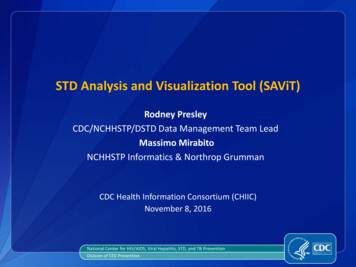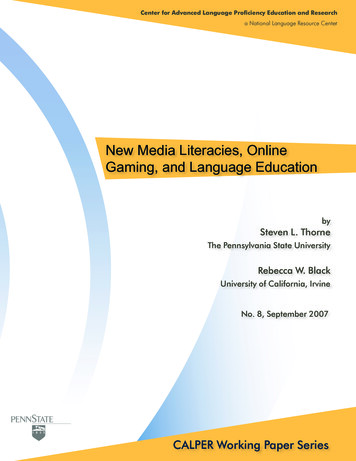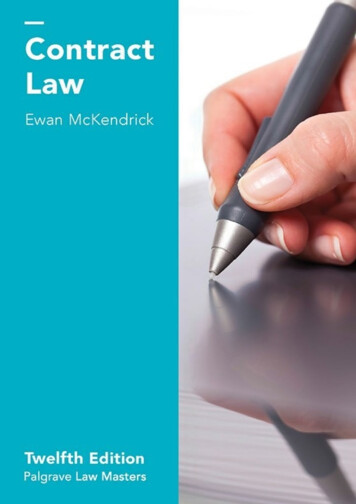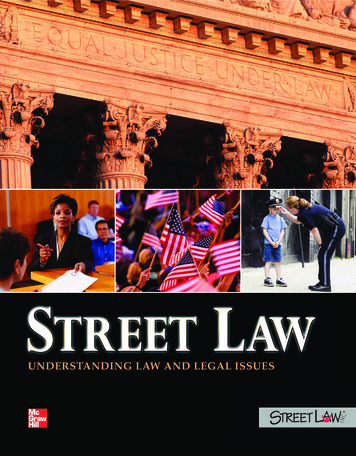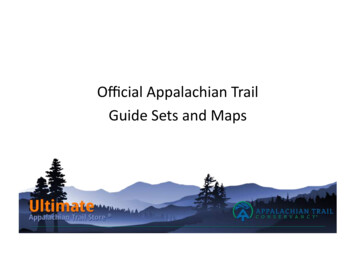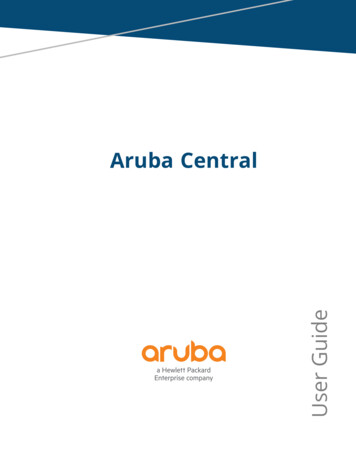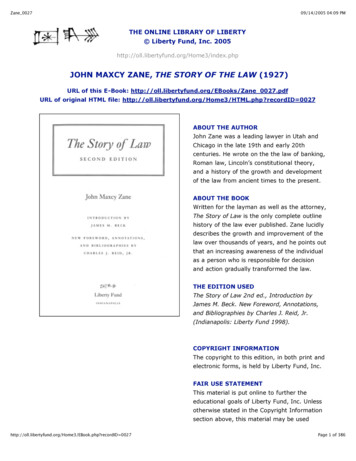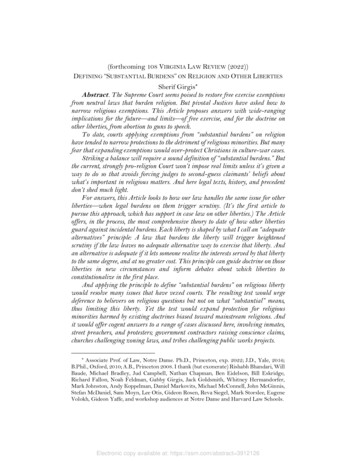
Transcription
(forthcoming 108 VIRGINIA LAW REVIEW (2022))DEFINING “SUBSTANTIAL BURDENS” ON RELIGION AND OTHER LIBERTIESSherif Girgis Abstract. The Supreme Court seems poised to restore free exercise exemptionsfrom neutral laws that burden religion. But pivotal Justices have asked how tonarrow religious exemptions. This Article proposes answers with wide-rangingimplications for the future—and limits—of free exercise, and for the doctrine onother liberties, from abortion to guns to speech.To date, courts applying exemptions from “substantial burdens” on religionhave tended to narrow protections to the detriment of religious minorities. But manyfear that expanding exemptions would over-protect Christians in culture-war cases.Striking a balance will require a sound definition of “substantial burdens.” Butthe current, strongly pro-religion Court won’t impose real limits unless it’s given away to do so that avoids forcing judges to second-guess claimants’ beliefs aboutwhat’s important in religious matters. And here legal texts, history, and precedentdon’t shed much light.For answers, this Article looks to how our law handles the same issue for otherliberties—when legal burdens on them trigger scrutiny. (It’s the first article topursue this approach, which has support in case law on other liberties.) The Articleoffers, in the process, the most comprehensive theory to date of how other libertiesguard against incidental burdens. Each liberty is shaped by what I call an “adequatealternatives” principle: A law that burdens the liberty will trigger heightenedscrutiny if the law leaves no adequate alternative way to exercise that liberty. Andan alternative is adequate if it lets someone realize the interests served by that libertyto the same degree, and at no greater cost. This principle can guide doctrine on thoseliberties in new circumstances and inform debates about which liberties toconstitutionalize in the first place.And applying the principle to define “substantial burdens” on religious libertywould resolve many issues that have vexed courts. The resulting test would urgedeference to believers on religious questions but not on what “substantial” means,thus limiting this liberty. Yet the test would expand protection for religiousminorities harmed by existing doctrines biased toward mainstream religions. Andit would offer cogent answers to a range of cases discussed here, involving inmates,street preachers, and protesters; government contractors raising conscience claims,churches challenging zoning laws, and tribes challenging public works projects. Associate Prof. of Law, Notre Dame. Ph.D., Princeton, exp. 2022; J.D., Yale, 2016;B.Phil., Oxford, 2010; A.B., Princeton 2008. I thank (but exonerate) Rishabh Bhandari, WillBaude, Michael Bradley, Jud Campbell, Nathan Chapman, Ben Eidelson, Bill Eskridge,Richard Fallon, Noah Feldman, Gabby Girgis, Jack Goldsmith, Whitney Hermandorfer,Mark Johnston, Andy Koppelman, Daniel Markovits, Michael McConnell, John McGinnis,Stefan McDaniel, Sam Moyn, Lee Otis, Gideon Rosen, Reva Siegel, Mark Storslee, EugeneVolokh, Gideon Yaffe, and workshop audiences at Notre Dame and Harvard Law Schools.Electronic copy available at: https://ssrn.com/abstract 3912126
(forthcoming 108 VIRGINIA LAW REVIEW (2022))TABLE OF CONTENTSINTRODUCTION . 3I. THE CHALLENGE . 7A. GAPS IN LEGAL SOURCES.9B. EXISTING ANSWERS (AND THEIR DILEMMAS) . 111. Conduct-Focused Tests .112. Cost-Focused Tests.133. Claimant-Focused Tests .134. Common Law-Focused Tests.15C. THE HOLE IN HOBBY LOBBY AND FULTON . 16II. THE SOLUTION FOR OTHER LIBERTIES: THE ADEQUATEALTERNATIVES PRINCIPLE . 18A. TRACING THE PRINCIPLE ELSEWHERE . 201. Free Speech .212. Abortion .223. Travel.234. Guns .245. Some Pre-Smith Free Exercise Cases .25B. WHAT MAKES AN ALTERNATIVE “ADEQUATE”? . 27III. APPLICATIONS TO RELIGION: “SUBSTANTIAL BURDENS”. 29A. AN ADEQUATE ALTERNATIVES PRINCIPLE FOR RELIGION . 30B. WHAT IS COVERED: ACHIEVING THE RIGHT SCOPE . 331. Religious conduct protected .332. Legal burdens protected against .34C. WHO DECIDES: SETTING LIMITS WHILE AVOIDING RELIGIOUSQUESTIONS . 361. No theology by judges .362. Meaningful narrowing of successful claims .383. No superfluous element.39D. WHAT RESULTS . 401. Regulating internal affairs: religious minorities and governmentcontractors .402. Preferences, desires, and substantiality: prisons and zoning .433. No religious privilege in speech: evangelists and abortion protestors.46CONCLUSION . 48Electronic copy available at: https://ssrn.com/abstract 39121262
(forthcoming 108 VIRGINIA LAW REVIEW (2022))INTRODUCTIONDoes the Free Exercise Clause entitle people to exemptions from generallaws that happen to burden their religion? For decades, the Supreme Courtsaid yes. 1 Then in Employment Division v. Smith (1990),2 it said no. Now, inFulton v. City of Philadelphia (2021),3 five Justices have signaled a willingnessto reverse Smith and say yes again.4 That would restore heightened scrutinyof—and exemptions from—neutral laws that incidentally burden religion.But two pivotal Justices in Fulton said that if and when the Court reversesSmith, it will face several questions about what to replace Smith with. ThisArticle proposes answers, with wide-ranging implications for the future—and limits—of free exercise rights. Its framework also provides a method fordeveloping doctrines on other liberties, from abortion to guns to speech—and for telling which liberties a system ought to constitutionalize at all.Under the pre-Smith regime, which exists now in more limited contextsunder some federal and state statutes, courts would ask if a law had“substantially burdened” a person’s religious exercise. If so, courts wouldapply heightened scrutiny, granting her an exemption from the law unlessdoing so would have harmed a compelling interest. 5 But how to test forsubstantial burdens? That is, when should heightened scrutiny kick in?This Article develops answers based on how our law handles the sameissue as it arises for other constitutional liberties—when legal burdens onthem are serious enough to trigger heightened scrutiny. 6 Courts havedeveloped large bodies of case law on that question. And in answering thisissue for one liberty, courts have often drawn on the doctrines defining thetrigger for heightened scrutiny under other liberties.7 Some Justices havehinted that borrowing from other liberties might be the best way to limitreligious liberty, too (and one circuit has already gestured vaguely in thisdirection8).9 This method promises to provide a practical way for courts toSherbert v. Verner, 374 U.S. 398 (1968).Emp. Div. v. Smith, 494 U.S. 872 (1990).3 Fulton v. City of Philadelphia, 141 S. Ct. 1868 (2021).4 See id. at 1882 (Barrett, J., concurring, joined by Kavanaugh, J.) (finding “textual andstructural arguments against Smith more compelling”); id. at 1883 (Alito, J., joined byThomas and Gorsuch, JJ.) (calling for Smith to be overruled).5 Sherbert, 374 U.S. at 406, 407.6 See infra Section II.A.7 Ibid.8 See infra notes 229–232.9 Ibid.123Electronic copy available at: https://ssrn.com/abstract 3912126
(forthcoming 108 VIRGINIA LAW REVIEW (2022))limit religious liberty. But this Article is the first to pursue this approach—offering, in the process, the most comprehensive theory to date of howconstitutional liberties in general guard against incidental burdens.As shown below, courts have relied on what I call an adequate alternativesprinciple.10 This principle triggers heightened scrutiny of a law that burdensa civil liberty if the law leaves no adequate alternative means of exercising theliberty at issue. And an alternative is adequate if it allows people to pursue theinterests served by that liberty to the same degree and at no greater cost.This Article shows that applying that principle to religion offers easyto-implement answers to several questions about the scope of religiousliberty. The answers are especially timely as critics fear that if and when thisparticular Court reinstates free exercise exemptions, it will fail to imposesensible limits on exemptions. The concern not to over-protect has arisenespecially in politically charged cases raising Christian claims in the“conscience wars.”11 These include Fulton itself, which involved a Catholicagency declining to work with same-sex couples as foster parents.There and elsewhere, if courts found a “substantial burden” anytimesomeone claimed one, however trivial the burden in fact was, courts wouldbe doing what skeptics of exemptions—and several Justices in Fulton12—oppose: replacing Smith’s categorical denial of exemptions with “an equallycategorical strict scrutiny regime,”13 as Justice Barrett put it. This wouldgive religious claimants carte blanche. To avoid doing so, courts must insist,as Justice Sotomayor once wrote of a statutory religious exemptions regime,that merely “thinking one’s religious beliefs are substantially burdened” doesnot “make it so.”14But as Part I shows, a single fear has stopped the Court from setting reallimits on “substantial burdens,” including in culture-war-related cases likeBurwell v. Hobby Lobby.15 The Court has worried that any attempt to limitSee infra Part II.Douglas NeJaime & Reva B. Siegel, Conscience Wars: Complicity-Based ConscienceClaims in Religion and Politics, 124 YALE L.J. 2516 (2015).12 Justice Barrett wrote an opinion, joined in full by Justice Kavanaugh, that indicateda willingness to revisit Smith. (Both Justices may be needed for a majority to reverse Smithsince only three Justices called for reversal outright. See Fulton, 141 S. Ct. at 1883 (Alito,J., joined by Thomas and Gorsuch, JJ.)). Justice Breyer joined the portion of Justice Barrett’sopinion raising questions about what would replace Smith. Justice Breyer himself hadpreviously joined an opinion arguing that Smith was wrongly decided. See City of Boernev. Flores, 521 U.S. 507, 544, 545 (1997) (O’Connor, J., dissenting, joined by Breyer, J.).13 Fulton, 141 S. Ct. at 1883.14 Wheaton Coll. v. Burwell, 573 U.S. 958, 134 S. Ct. 2806, 2812 (2014) (Sotomayor, J.,dissenting).15 Burwell v. Hobby Lobby, 573 U.S. 682 (2014) (granting religious exemptions froma federal regulation requiring employers to provide insurance coverage for contraceptives).1011Electronic copy available at: https://ssrn.com/abstract 39121264
(forthcoming 108 VIRGINIA LAW REVIEW (2022))successful claims would require judges to play theologians, deciding forthemselves what is true or important in religious matters.16 (The risk offorcing judges into this role also concerned the Justices in Fulton who heldoff on reversing Smith pending more clarity on how to limit exemptions.17)So for any “substantial burdens” test to have a shot at appealing to thisstrongly pro-religion Court, it will have to avoid forcing judges to dotheology. This Article offers a practical test that does so while still imposingreal limits on religious claims in culture-war cases. But as seen in manyother applications below, this test is also well-suited “the vast majority ofclaims brought under” religious liberty statutes, which “have nothing to dowith topics like contraception, gay rights, or abortion.”18The substantial burden test proposed here also aims to avoid a secondproblem, which has plagued lower courts’ substantial burden doctrines: Byrelying on concepts drawn from mainstream religions, courts have harmedreligious minorities.19 So for minorities and also (as seen below) inmates, thesubstantial burden test has been “the most difficult doctrinal hurdle” toclear.20 (One study found that courts hearing “Muslim prisoner claims” oftensecond-guessed the prisoners’ religious views and “summarily den[ied]”their claims. 21 ) Because minorities bring the majority of claims (underexisting statutes), 22 refining the “substantial burden” test would meet apressing need whether or not Smith is reversed. That need arises in casesinvolving Apache Indians wearing headdresses with eagle feathers, Sikhscarrying kirpans to work, Santería priests performing sacrifices, blackchurches using inner-city spaces, Muslim prisoners growing beards, andBurwell, 573 U.S. at 725. The risk of forcing judges into this role also concerned theSmith Court, see 494 U.S. at 888–89,17 Fulton, 141 S. Ct. at 1883 (Barrett, J., concurring, joined by Breyer and Kavanaugh,JJ.) (citation omitted).18 Mark Storslee, Religious Accommodation, the Establishment Clause, and Third-PartyHarm, 86 U. CHI. L. REV. 871, 874 (2019); see also Luke W. Goodrich & Rachel N. Busick,Sex, Drugs, and Eagle Feathers: An Empirical Study of Federal Religious Freedom Cases, 48SETON HALL L. REV. 353, 384 (2018).19 See infra Section III.D.1.20 Michael Helfland, Identifying Substantial Burdens, 2016 U. ILL. L.R. 1772, 1777 (2016).21 Adeel Mohammadi, Note, Sincerity, Religious Questions, and the Accommodation Claimsof Muslim Prisoners, 129 YALE L.J. 1836 (2020).22 Over five years in the Tenth Circuit, “half of all decisions involve[d] prisoners orasylum seekers,” over half of whom were non-Christians. Luke W. Goodrich & Rachel N.Busick, Sex, Drugs, and Eagle Feathers: An Empirical Study of Federal Religious Freedom Cases,48 SETON HALL L. REV. 353, 356 (2018). Among non-prisoner and non-asylum cases,Muslims were overrepresented by a ratio of 11.86:1, Native Americans 6.78:1,Fundamentalist Mormons 5.08:1, and Hindus 3.39:1. Id. at 374.165Electronic copy available at: https://ssrn.com/abstract 3912126
(forthcoming 108 VIRGINIA LAW REVIEW (2022))Jewish inmates keeping kosher.23 This Article’s substantial burden test aimsto offer protection in such cases, without over-protecting in others.But as Part II reveals, this basic problem—developing a balanced butlimited trigger for exemptions from incidental burdens—isn’t unique toreligious liberty. Courts face the same challenge in implementing otherconstitutional liberties. For example, this exact issue arose regardingabortion in Planned Parenthood v. Casey.24 In fact, it’s an underappreciatedfact that the changes Casey made to Roe v. Wade were entirely about limitingwhich incidental burdens on pre-viability abortion would require acompelling justification and which would not.25 And Casey’s express reasonfor introducing this distinction into abortion law was to bring abortion inline with all other constitutional liberties, under which “not every law whichmakes [the liberty] more difficult to exercise is, ipso facto, an infringementof that right.” 26 Specifically, Casey held, only laws imposing an “undueburden” on abortion should require a compelling justification. And whilethis test was criticized as novel, its substance resembled doctrines playingthe same narrowing role for other liberties. Bringing out the resemblancehere will show how to extend those other liberties’ doctrines to newcircumstances—and how to fashion a well-supported “substantial burden”test for religion, in the absence of textual or historical guidance for doingso.To that end, Part II draws a principle from the law of speech, abortion,and other liberties. These liberties not only forbid state action that targetsprotected conduct. They also guard against incidental burdens from neutrallaws—but only some. Which? The law’s answer is given by what I call anadequate alternatives principle. This principle triggers heightened scrutiny ofa law burdening a civil liberty if the law leaves us no adequate alternative meansof exercising the liberty. But courts have said little on what makes analternative “adequate.” To derive an answer, Part II extrapolates from caselaw and rights theory. Ultimately, the adequate alternatives principleCorvino, et al., Introduction, in CORVINO, ET AL., DEBATING RELIGIONS LIBERTY ANDDISCRIMINATION (2017), at 15.24 Planned Parenthood of Se. Pa. v. Casey, 505 U.S. 833 (1992).25 It is sometimes supposed that Casey did away with Roe’s heightened scrutiny—Roe’sdemand for a compelling justification for abortion laws—altogether. See, e.g., Mark D.Rosen, Christopher W. Schmidt, Why Broccoli? Limiting Principles and PopularConstitutionalism in the Health Care Case, 61 UCLA L. REV. 66, 95 (2013) (Casey “rejected Roev. Wade’s test of strict scrutiny, adopting in its place the new and unique undue burdenstandard”). But in fact Casey did not “disturb” but rather “reaffirm[ed]” what it called Roe’s“essential holding” on when the state interest in fetal life was and wasn’t constitutionallysufficient to support laws preventing abortion—and thus also reaffirmed, implicitly, Roe’sdemand that such laws serve a compelling interest. 505 U.S. at 879.26 Id. at 874 (plurality opinion).23Electronic copy available at: https://ssrn.com/abstract 39121266
(forthcoming 108 VIRGINIA LAW REVIEW (2022))ensures that laws curbing some liberty will leave people other ways topursue the interests served by that liberty to the same degree, at no greatercost. This account can be used to clarify the scope of any number of liberties.Finally, Part III applies the account to limit findings of “substantialburdens” on religion.27 It offers a unified resolution of dozens of cases andseveral unsettled questions. The cases addressed involve prisoners anddeath row inmates; street preachers and protesters; government contractorsraising conscience claims, churches challenging zoning laws, and tribeschallenging public works projects. And the legal questions addressedinclude several other puzzles raised by Justices in Fulton—about whatquestions judges should ask in assessing “substantiality,” whether to subjectall “garden-variety laws”28 to review, whether to treat “indirect and directburdens on”29 religion differently, what forms of religious exercise to countin the first place, when to defer to claimants’ beliefs about a burden’ssignificance and when not to. The test will ensure that heightened scrutinyapplies only when the religious claimant really is worse off than otherssubject to the same law, allaying concerns about over-protecting religion.But the test will also avoid the constitutional landmines of having judges dotheology or giving short shrift to less familiar, minority religious claims.I. THE CHALLENGEBoth pre-Smith free exercise protections against incidental burdens onreligion, and some current statutory protections, limit relief to casesinvolving a substantial burden on religion. This Part reviews the challengesthat courts and commentators face in defining “substantial burden.”It helps to have background about the test’s place in our scheme of civilliberties. (By “civil liberties” I simply mean rights to freedom from stateinterference in private conduct. These include many constitutional rights,but not all.30) In our system, a constitutional liberty to do X—engage inOther scholars have discussed the adequate alternatives principle in the context ofreligion but to opposite effect—arguing that because such alternatives are hard to come byin the case of religion, religious burdens should trigger stricter protection. See DouglasLaycock and Thomas C. Berg, Protecting Free Exercise under Smith and after Smith, 2020CATO SUP. CT. REV. 33, 4728 Fulton, 141 S. Ct. at 1883 (Barrett, J., concurring, joined by Breyer and Kavanaugh,JJ.) (citation omitted).29 Ibid.30 Contrast such liberties with rights that are entitlements to government resources—to counsel, a fair trial, a vote—which aren’t addressed here except insofar as thegovernment might deny one of these resources in a way that penalizes the exercise of aliberty. Of course, this private conduct/public resources dichotomy is not sharp or277Electronic copy available at: https://ssrn.com/abstract 3912126
(forthcoming 108 VIRGINIA LAW REVIEW (2022))speech, travel, keep and bear arms, exercise religion, obtain an abortion—has two jobs. Not only does a civil liberty prohibit laws whose purpose is toforbid X (what I’ll call “targeted” laws). It also protects against some lawsthat have only the side effect of burdening X (“non-targeted” laws).31This Article focuses on this second protection—from non-targeted laws.When it comes to such laws, as seen below, most constitutional libertiesrequire a two-step inquiry from courts. The first concerns the burden on theindividual’s conduct, and the second is about the public benefits of imposingthat burden. A court reaches the second step only if it finds a weighty burdenon private conduct, at step one. It’s that first step that is governed by the“substantial burden” test in the case of religion. The test’s job, then, is toidentify when enough is at stake for the religious believer that courts shouldweigh the costs of granting her an exemption.Something that does this job is needed for review of laws incidentallyburdening religion, but not for review of laws targeting religion. Targetedlaws, as courts and commentators agree, are unlawful whether or not theburden they impose is “substantial.”32 The law should, and can afford to, bartargeted laws across the board, because there is never a good reason totarget religion for the sake of targeting religion.33By contrast, non-targeted laws aim at legitimate interests; any harm toreligion is incidental. Heightened scrutiny of non-targeted laws is sometimesneeded, because incidental burdens can be just as harmful to constitutionalliberties as targeted laws. 34 But guarding against all incidental burdensmight drown courts and cripple the state’s pursuit of what are, after all,legitimate interests. The doctrine meant to hold back the flood (and preventthe crippling) under pre-Smith free exercise law was the “substantial burden”test: Only substantial burdens on free exercise would trigger strict scrutinyand thus, potentially, exemptions.exhaustive. Some entitlements both spare you from government interference in privateconduct and entitle you to certain government aid (like property rights). And others areabout neither private conduct nor access to such resources, but some other form of stateaction or abstention (like equal protection or non-establishment).31 See generally Michael C. Dorf, Incidental Burdens on Fundamental Rights, 109 HARV. L.REV. 1175 (1996).32 See, e.g., Tenafly Eruv Ass’n, Inc. v. Borough of Tenafly, 309 F.3d 144, 170 (3d Cir.2002) (“[T]here is no substantial burden requirement when government discriminatesagainst religious conduct.”) (citing Church of Lukumi Babalu Aye v. City of Hialeah, 508 U.S.520, 531–47 (1993).33 Cf. Brown v. Borough of Mahaffey, 35 F.3d 846, 849–50 (3d Cir. 1994) (“Applyingsuch a burden test to non-neutral government actions would make petty harassment ofreligious institutions and exercise immune from the protection of the First Amendment.”).34 See generally Dorf, supra note 31.Electronic copy available at: https://ssrn.com/abstract 39121268
(forthcoming 108 VIRGINIA LAW REVIEW (2022))That crucial role makes it all the more important to define “substantialburdens” well. This Part will show why that’s a challenge and surveyproblems with existing “substantial burden” tests, to motivate Part III’sdefense and application of a new test.A. Gaps in Legal SourcesThe usual sources of legal authority offer little help in shaping a“substantial burden” doctrine.First, neither the text nor the original understanding of the FirstAmendment sets the scope of the “substantial burdens” test. After all, thetest didn’t appear until the Court’s 1968 decision inaugurating religiousexemptions from neutral laws, in Sherbert v. Verner. 35 Even the leadingoriginalist defenders of free exercise exemptions do not claim that originalunderstandings tell us which burdens on religion were thought significantenough to require special justification.36 At most history tells us what sortof justification was thought sufficient to override a free exercise claim:according to “early colonial charters” and “State constitutions,” only theneed to preserve “peace and safety.”37So at most, history speaks to the question raised at step two of theinquiry under civil liberties doctrines today: how to apply heightenedscrutiny. History is silent on the prior question of when there is a sufficientclash between a law and someone’s religion to trigger scrutiny. Thatquestion really encompasses several issues: Which conduct is protectedexcept when it would undermine peace and safety? (All religiouslymotivated conduct? Only religious obligations? Something in between?)And what is that conduct protected against? (Criminal penalties? Civil? Theindirect pressure of losing otherwise available public benefits?) Historydraws a blank on these questions about defining “substantial burdens.”Second, precedent on the “substantial burden” test was conflicted andunderdeveloped. While Sherbert found a substantial burden when a statebanned nothing and just incidentally raised the cost of religious exercise,Sherbert also officially left in place a then-recent precedent blessing laws thatmake “religious practices” “not unlawful” but merely “more expensive.”38 Oragain, while Sherbert looked askance at laws increasing the “expense” ofreligion, a later Sherbert-era case allowed state action that the Court374 U.S. 398, 406, 407 (1968).See, e.g., Michael W. McConnell, Freedom from Persecution or Protection of the Rights ofConscience: A Critique of Justice Scalia’s Historical Arguments in City of Boerne v. Flores, 39Wm. & Mary L. Rev. 819, 824–25 (1997) (offering evidence only on the question of whena burden on religion would be constitutionally tolerated).37 Fulton, 141 S. Ct. at 1902 (Alito, J., concurring).38 Braunfeld v. Brown, 366 U.S. 599, 605–06 (1961).35369Electronic copy available at: https://ssrn.com/abstract 3912126
(forthcoming 108 VIRGINIA LAW REVIEW (2022))admitted might “virtually destroy[]” a native American tribe’s ability topractice their faith.39 Indeed, Justice Scalia’s opinion for the Court in Smitheffectively abolishing the Sherbert regime did so on the ground that it was“utterly unworkable.”40Third, besides tensions in the precedents, there were gaps. The Courtgave little or no guidance on several questions that have become pressingand contentious41: whether to look at the theological burden of compliancewith a law as well as the material burden for non-compliance; when to deferto claimants’ views about those matters and when not to; what range of stateactions to regard as candidates for review, and which forms of religiousexercise to count as candidates for protection.Fourth, the same questions (and lack of guidance) have arisen under thestatutes Congress enacted when the Supreme Court in Smith scrapped theconstitutional entitlement to exemptions. Like pre-Smith cases, theReligious Freedom Restoration Act of 1993 (RFRA)42 provided for strictscrutiny of only “substantial[]” burdens on religion (whether imposed bystate or federal action). And when RFRA was invalidated as applied to thestates, 43 Congress restored some protection against state action (wherejurisdictional hooks existed) with the Religious Land Use andInstitutionalized Persons Act of 2000 (RLUIPA).44 RLUIPA, too, demandsstrict scrutiny only in case of “substantial[] burdens” on religion (in thecontext of zoning laws and policies affecting prisoners).And in passing both statutes, RFRA and RLUIPA, Congress added noclarity on “substantial burdens.” The text and legislative history simplypoint back to the Court’s Sherbert-era cases, 45 which are spotty andconflicted. And since then, Congress’s one amendment of the statutory“substantial burden” test clarified only what is not required for such a burden(namely, that the affected conduct be “compelled by or central to” one’sfaith46).Fifth, dictionaries won’t help much in interpreting the “substantialburden” language as it appears in RFRA and RLUIPA because the term“substantial” is vague. That’s why the term takes on different senses in39
(forthcoming 108 VIRGINIA LAW REVIEW (2022)) 5 successful claims would require judges to play theologians, deciding for themselves what is true or important in religious matters.16 (The risk of forcing judges into this role also concerned the Justices in Fulton who held off on reversing Smith pending more clarity on how to limit exemptions.17) So for any "substantial burdens" test to have .
